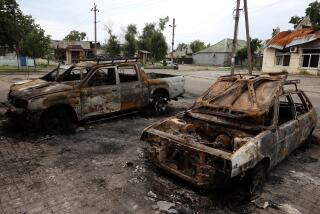Iraq Has Bomb Similar to an Atomic Weapon
- Share via
WASHINGTON — Iraq has developed a new type of high-explosive weapon capable of delivering a devastating blast similar to a small nuclear explosion over an area several miles wide, according to Pentagon officials.
The weapon, known as a fuel-air explosive, is particularly effective against air bases, oil fields and troops in the open, according to military experts. Unlike Iraq’s arsenal of chemical and biological weapons, there is no ready defense against this type of device.
“It’s not your garden-variety weapon,” said Henry Sokolski of the Pentagon’s international security affairs office. “These are blast-effect weapons, and what you can’t see can kill you.”
Concern is mounting about the threat the exotic explosive, which can have 10 times the power of conventional explosives--and which the United States does not have in its arsenal--poses to American troops in the Persian Gulf deployment.
Five senators, including John Glenn (D-Ohio) and Jesse Helms (R-N.C.), have sent a letter to Defense Secretary Dick Cheney asking for an investigation of the size and sophistication of Iraq’s supply of fuel-air explosives and whether U.S. technology was used in the weapon’s development.
Earlier reports have indicated that the know-how for building these bombs was supplied to Iraq indirectly through the German arms industry. But a congressional investigator said that U.S. technology may have been involved as well.
Fuel-air explosives, or FAE for short, are a kind of gas bomb involving two detonations. The principle is similar to filling a room with natural gas, then tossing in a match.
The bomb or missile warhead contains fuel, usually propane or ethylene oxide. An initial explosion disperses the fuel into the air. A second, time-delayed detonation ignites the mixture of fuel and air, creating a huge fireball and shock wave.
The invisible shock wave is similar to that of a tactical nuclear weapon and spreads rapidly across a wide area. The shock wave is capable of flattening buildings, destroying aircraft, knocking down oil rigs and killing troops, according to Pentagon experts.
At peak efficiency, FAEs have destructive effects 10 times more powerful than conventional explosives of the same size, according to Pentagon estimates. Even the least efficient FAE, if ignited correctly, has double the explosive yield of a conventional weapon.
An analysis by U.S. intelligence officials indicates that its effectiveness against personnel has been underestimated by the Defense Department. In addition, the analysis said the bomb is especially potent in clearing mine fields and destroying fuel depots, ammunition supplies and radar vans.
FAEs can be launched as bombs from airplanes or as warheads on missiles. Missile-delivered warheads would be the most difficult kind for U.S. forces to defend against. But Pentagon officials said there is no clear evidence Iraq is capable of mounting the devices on missiles.
However, said one military analyst, “there is nothing magical about putting these things on rockets or missiles.”
Iraqi President Saddam Hussein has mounted an intensive international campaign in recent years to buy sensitive Western technology to develop a variety of weapons, including long-range ballistic missiles capable of carrying FAEs.
Western analysts do not believe that Iraq possesses accurate, long-range missiles. However, a Pentagon analyst said the far-reaching power of the FAE makes it especially well suited to compensate for the presumed inaccuracy of Iraqi missiles.
There seems to be little doubt that Iraq possesses FAEs. At an arms show in Baghdad in April, 1989, Husayn Kamil, the head of the Iraqi Military Production Authority, displayed one of three types of FAEs that he said the country has produced. Pentagon officials also cited recent reports in the European press offering evidence that Iraq “has perfected the weapon for air delivery.”
The BBC’s Panorama news show recently identified a major German aerospace and defense firm, Messerschmitt-Bolkow-Blohm, as helping Iraq develop the technology for an advanced version of the FAE through a missile project with Egypt.
Willie Vogler, the head of public relations for the German firm, said in a telephone interview Thursday that feasibility studies on an FAE device were conducted as part of a missile project with the Egyptian government. Portions of the bomb were tested, although not the entire device.
But Vogler said the FAE project was terminated in 1988. The project ended because of pressure on Egypt by Western governments. At the time, Egypt had received technical studies from the German firm for developing the FAE, but not enough information to actually build a device, said Vogler.
According to the BBC and Der Spiegel, a German magazine, the Egyptians passed on the FAE studies to the Iraqis. They also reported that former employees of the German company have helped Iraq develop ballistic missiles capable of delivering an FAE warhead.
Pentagon experts said that technical information about the bomb has been distributed widely throughout the world. The weapons are in the arsenals of the Soviet Union, Israel, China, France, West Germany and Spain and may be possessed by Third World countries in addition to Iraq.
In the early to mid-1980s, the United States investigated fuel-air explosives as a means of reducing its reliance on nuclear weapons. But the United States has not developed an arsenal of the devices.
IRAQ’S NEW WEAPON 1. The fuel-air explosive can be launched as a bomb from an airplane or as a warhead on a missile. The bomb or missile warhead usually contains propane or ethylene oxide. 2. An initial explosion disperses the fuel in the air. 3. A second, time-delayed explosion ignites the mixture of fuel and air. The principle is similar to throwing a match into a gas-filled room. The resulting fireball and shock wave can cover an area several miles wide. The blast is similar to that of a small nuclear device. At peak efficiency, it is 10 times more powerful than a conventional weapon of the same size. The shock wave alone is capable of flattening buildings and oil rigs. Weight: 500 pounds Length: 85 inches Diameter: 14 inches Guidance: None Source: Pentagon
More to Read
Sign up for Essential California
The most important California stories and recommendations in your inbox every morning.
You may occasionally receive promotional content from the Los Angeles Times.











